Key Developments in the History
of Gravity Dams
|
Ancient Times
Jawa
The world's most ancient, well researched and documented dams to this day are the Jawa
gravity dams, located in Jordan. They were part of an elaborate water supply system
for the town of Jawa, which experienced a brief heyday around 3000 BC. Located in an
inhospitable basalt desert, the city, laid out for some 2000 inhabitants, must have
been built very rapidly. It is likely that its construction had to start together
with that of the water system at the beginning of the rainy season, if the builders
and their herds should survive the following dry period. |
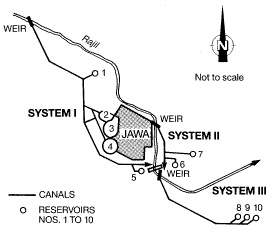
Map of Jawa Water System
sketch from Schnitter
courtesy of
A.A. Balkema (#)
|
|
The Jawaites satisfied their water needs during construction of the city by daming
runoff to form artificial reservoirs. In order to fill these, canals were built from
the Rajil river. Half of the storage capacity of the reservoirs was concentrated in
Reservoir #4, which was impounded by a 4.5 m high and 80 m long dam.
The internal structure of this dam was quite
complex. It had two dry masonry walls which enclosed an earth core of
thickness 2 m. Additionally an impervious blanket was provided in front of the
upstream heel. The stability of the structure was assured by a downstream
embankment. The heightening of the dam by 1 m followed essentially the same
principles, although the width of the earth core was now increased to some 7
m. A previous stone fill was provided behind its upstream wall for easy
drainage during emptying of the reservoir. Thus the wall was protected against
the dangers of water-backpressures, a precautionary measure that was
reinvented only in modern times! For unexplained reasons, this miraculous
desert city collapsed as swiftly as it rose. It might even have become a
victim of its success--too many people may have overstressed the water supply systems.
|
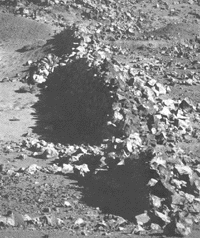
Remains of Jawa Dam
photo from Schnitter
courtesy of
A.A. Balkema (#)

Cross Section of Jawa Dam
photo from Schnitter
courtesy of
A.A. Balkema (#)
|
The Roman Empire
Emperor Nero (AD 54-68) had a 40 m high, 13.5 m wide, and 80 m lonldam built for a pleasure
lake near his villa at Subiaco, Italy. The dam was one of the earliest Roman dams and
remained the highest the Romans ever built. Moreover, the Subiaco dam and two smaller
dams nearby are the only Roman dams in Italy. Although the dam was too thin,
it remained intact until it failed in 1305. Records place the blame on two
monks who took it upon themselves to remove stones from the dam, apparently
in an attempt to lower the level of the lake which was flooding their fields.
Inside a monastary near the dam hangs a painting from 1428 showing St. Benedict
fishing from the crest of the Subiaco Dam. Incedentally, this painting is the oldest
surviving illustration of a dam.
|

Painting of the Subiaco Dam
photo from Schnitter
courtesy of
A.A. Balkema (#)
|
|
In extreme contrast to the number of Roman dams in Italy, Roman gravity dams were
abound in the Iberian peninsula, North Africa, and the Middle East. The largest
reservoir impounded by the Romans was created by a dam located near Homs, Syria in
284 AD. The dam had the extraordinary length of 2000 m and impounded approximately
90 million m3 of water. The main body of the dam consisted of concrete
lined by masonry on both slightly inclined faces and on the crest. It was also grossly
overdesigned: in its central part, the dam was 7 m high and 14 m wide . The crest width
was smaller, but still measured 6.6 m for the upper 1.3 m of height.
|
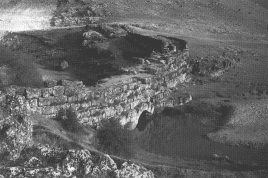
Typical Roman Gravity Dam
photo from Schnitter
courtesy of
A.A. Balkema (#)
|
|
Later Dams
The record height of the Roman Subiaco dam wasn't broken until 1594 with the construction of
the 46 m high Tibi dam in Spain. However, the Roman concept of a rectangular wall was mostly
maintained, with only a few, hesitant attempts to use trapezoidal, let alone the correct
triangular, cross sections. The use of concrete by the Romans for the dams' interior or
as a building material in general, fell into oblivion, while the construction techniques
essentially remained the same: pick and shovel.
|
Evolution of the Modern Gravity Dam
|
|
The Correct Shape
In 1765 and 1800, the first triangular gravity dams were built in Mexico. Unfortunately, it
remains unknown who their ingenious builder was. Amazingly, he/she had adopted the modern
shape almost one century before it was developed in France.
In 1850, French engineer J. Augustin Tortene de Sazilly (1812-1852) showed in a
lecture that the most advantagous profile for a gravity dam is triagle with a verticle
upsteam face. Sazilly also analyzed three recent French navigation dams in a paper
published posthumously in 1853. He used the cross sections of these three dams to
illustrate the confusion and uncertainty in the design of gravity dams. In fact,
two of the dams were wrongly inclined on the upstream side!
|
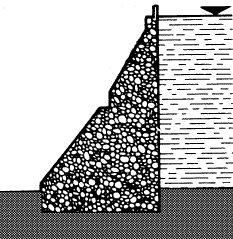
The Triangular Gravity Dam
sketch from Schnitter
courtesy of
A.A. Balkema (#)
|
|
Materials: The Return of Concrete
Concrete--now on the basis of Portland cement--was used for the first time since the
Romans for the Boyds Corner gravity dam completed in 1872 in New York. The Lower
Crystal Springs Dam in California, completed in 1890, was the first dam in which
the water content of the concrete was specifically controlled. Because the cement
industry was nonexistent in California, the cement had to be imported from England.
In 1892 in France and in 1918 in the United States it was scientifically determined
that by decreasing the amount of water in concrete and increasing the amount of
cement, the stronger it is. However, a minimum amount of water must be there to
ensure the workability of concrete while the amount of cement may need to be limited on
account of the heat it develops during the hardening process.
|

The Lower Crystal Springs Dam
photo courtesy of
the San Francisco Public Utilities Commission
|
BIG Gravity Dams: New Ideas in Construction!
|
|
Hoover Dam
The next big development was the construction of the Hoover Dam, built by the US
Bureau of Reclamation. It was a quantum jump in dams. Not only was it 60% higher
and 2.5 time larger than any any dam in existence, but it was also to impound the
unheard of quantity of 38,550 million m3 of water. The dam was built between
1931 and 1936 and was designed as a curved gravity dam. Concreting the Hoover Dam barely
took two years with some 5000 men placing up to 8000 m3 of concrete per day!
|
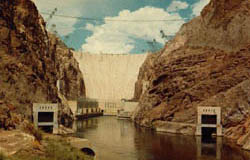
The Hoover Dam
photo from US Bureau of Reclamation
|
|
Grand Dixence Dam
The tallest of the concrete gravity dams is the Grande Dixence dam in the Swiss Alps
constructed from 1951 to 1962. It's 285 m high!
|
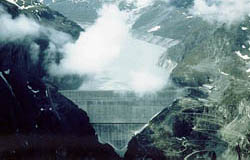
The Grand Dixence Dam
photo from VSE
|
Latest Ideas in Gravity Dams
Steel
A relatively new development in the construction of gravity dams is incorporation of
post-tensioned steel into the structure. This helped reduce the cross section of Allt
Na Lairige Dam in Scotland to only 60 percent of that of a conventional gravity dam of
the same height. A series of vertical steel rods near the upstream water face, stressed
by jacks and securely anchored into the rock foundation, resists the overturning
tendency of this more slender section. This system has also been used to raise
existing gravity dams to a higher crest level, economically increasing the storage
capacity of a reservoir. However, since reaching their prime in the 1960s, gravity
dams have become something like a dying species, the dinosaurs of an era which
especially the idustrialized countries with their high labor cost no longer can afford.
|
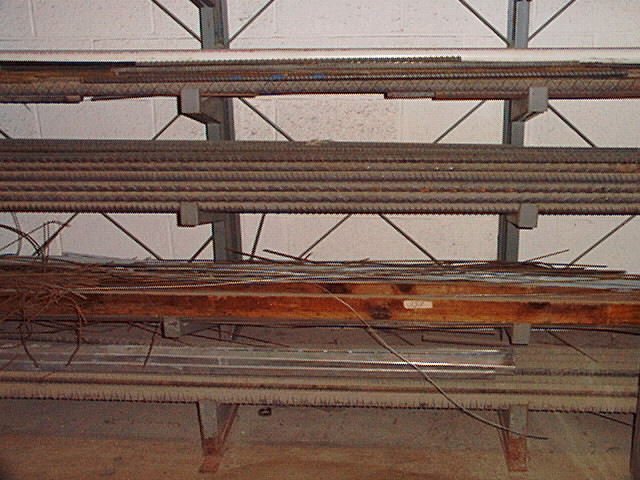
Steel Rods
photo by Megann
Polaha (#) |
 
|


